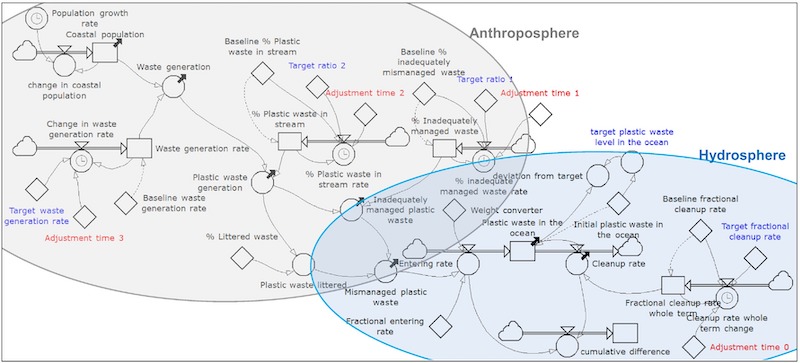How much innovation is needed to protect the ocean from plastic contamination?
Cordier M. & Uehara, T. (2019). How much innovation is needed to protect the ocean from plastic contamination?. Science of The Total Environment, Elsevier, Volume 670, 20 June 2019, Pages 789-799. https://doi.org/10.1016/j.scitotenv.2019.03.258
Abstract
Plastics are non-biodegradable, and increasing accumulation of plastic debris in the ocean is a major cause for concern. The World Economic Forum, Ellen MacArthur Foundation, and McKinsey & Company claimed in 2016 that technological innovations can solve the plastic problem. Such a claim raises an as yet unanswered question: how much technological innovation is needed and is it economically feasible? We offer answers to this question via a system dynamics model that we developed to simulate different scenarios aimed at controlling plastic debris entering the global ocean. Our results show that ocean cleanup technologies could achieve a 25% reduction in the level of plastic debris in the ocean below 2010 levels in 2030. However, this would require removing 15% of the stock of plastic debris from the ocean every year over the period 2020–2030, which equates to 135 million tons of plastic in total (metric tons). The implementation cost of such an ocean cleanup effort would amount to €492 billion-€708 billion, which represents 0.7%–1.0% of the world GDP in 2017 – this calculation is based on unit costs in €/kg estimated in The Ocean Cleanup project feasibility study. The Ocean Cleanup project alone is designed to collect 70,320 tons of plastic debris over a 10 year period. Removing 135 million tons of plastic debris would require investing in 1924 similar cleanup projects. These results help to assess the economic feasibility of removing such large volume of plastics. Moreover, our results provide quantitative confirmation that technological solutions alone are not sufficient to solve plastic pollution issues. A portfolio of diverse solutions – not only technological ones – is likely to have greater technical, political and economic feasibility. Our model shows that such a combined portfolio implemented over the period 2020–2030 could reduce the ocean plastic stock to 2013 levels (94 million tons) by 2030.

Figure 1. Correlation between annual inputs of plastic debris from land into the global ocean and world gross domestic product (GDP) over the period 1950-2015. In the equation of the linear regression (black continuous line), y = global plastic debris annual inputs from land to world's ocean (million tons/year), x = world GDP (constant 2010 US billion $) and - 0.99677 is the constant (i.e., the intercept with the vertical axis). Data on the vertical axis are our own calculations based on Eq. (6) in which we entered data from Jambeck et al. (2015) and Geyer et al. (2017). Data on the horizontal axis comes from the World Bank (2018).

Figure 2. Stock and flow diagram of the system dynamics model for marine plastic wastes (designed in Powersim). Stocks and flows are represented by boxes and double arrows, respectively. Circles and diamonds denote auxiliary variables and constants. Clouds indicate infinity and mark the model boundaries.
Keywords
Marine ecosystem, Waste management, Ocean cleanup, System dynamics, Decoupling GDP, Marine litter
Highlights
-
We develop a system dynamics model to study the issue of plastic debris in the ocean.
-
Technological solutions alone cannot solve ecological issues in a growing economy.
-
Significant ocean cleanup requires removing at least 135 million tons of plastics.
-
Such a removal effort might cost up to €708 billion, i.e., 1% of the world GDP.
-
A diverse portfolio of solutions, in the ocean and on land also, performs better.
